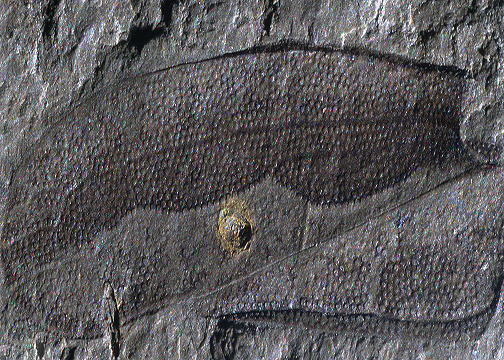Abstract
Granulidae is a small extinct hemipteran family with only two genera from the Middle Triassic of northern China. Here we describe and illustrate a new species of Granulidae, Sinogranulus jinsuoguanensis Fu & Huang sp. nov., from the Middle Triassic Yanchang Formation of Tongchuan City, Shaanxi Province, northern China, representing the second species of Sinogranulus Zhang, Chen & Zhang, 2022, adding new information on morphological diversity of this genus. In addition, Sinogranulus is emended and provided with a supplemental description for the type species Sinogranulus qishuiheensis based on four specimens from the same locality of Yanchang Formation with S. jinsuoguanensis sp. nov., and the intra-specific variation of venation in two species of Sinogranulus is discussed.
References
- Bourgoin, T., Wang, R.R., Asche, M., Hoch, H., Soulier-Perkins, A., Stroinski, A., Yap, S. & Szwedo, J. (2015) From micropterism to hyperpterism: recognition strategy and standardized homology-driven terminology of the forewing venation patterns in planthoppers (Hemiptera: Fulgoromorpha). Zoomorphology, 134, 63–77. https://doi.org/10.1007/s00435-014-0243-6
- Evans, J.W. (1946) A natural classification of leaf-hoppers (Homoptera, Jassoidea). Part 1. External morphology and systematic position. Transactions of the Royal Entomological Society of London, 96, 47–60. https://doi.org/10.1111/j.1365-2311.1946.tb00442.x
- Evans, J.W. (1950) A re-examination of an Upper Permian insect, Paraknightia magnifica Ev. Records of the Australian Museum, 22, 246–50. https://doi.org/10.3853/j.0067-1975.22.1950.605
- Evans, J.W. (1956) Palaeozoic and Mesozoic Hemiptera (Insecta). Australian Journal of Zoology, 4, 164–258. https://doi.org/10.1071/ZO9560165
- Fu, Y.Z., Azar, D. & Huang, D.Y. (2021) The first Dysmorphoptilidae from the Middle Triassic of China (Hemiptera: Cicadomorpha). Historical Biology, 33, 3506–3512. https://doi.org/10.1080/08912963.2021.1874374
- Hamilton, K.G.A. (1992) Lower Cretaceous Homoptera from the Koonwarra Fossil Bed in Australia, with a new superfamily and synopsis of Mesozoic Homoptera. Annals of the Entomological Society of America, 85, 423–430. https://doi.org/10.1093/aesa/85.4.423
- Hamilton, K.G.A. (1996) Cretaceous Homoptera from Brazil: implication for classification. In: Schaefer, C.W. (Ed.), Studies on Hemipteran Phylogeny. Lanham: Entomological Society of America, Thomas Say Publication, 89–110 pp.
- Handlirsch, B.A. (1906–1908) Die fossilen Insekten und die Phylogenie der Rezenten Formen: Ein Handbuch für Paläontologen und Zoologen. Engelmann, Leipzig, 1, 430 pp. https://doi.org/10.5962/bhl.title.34145
- Hong, Y.C. (1980) Granulidae, a new family of Homoptera from the Middle Triassic of Tongchuan, Shaanxi Province. Acta Zootaxonomica Sinica, 5, 63–70. [In Chinese with English abstract]
- Latreille, P.A. (1802) Histoire naturelle, générale et particulière des crustacés et des insectes. Ouvrage faisant suite à l’histoire naturelle, générale particulière, composée par Leclerc de Buffon et rédigé par C.S. Sonnini, membre de plusieurs sociétés savantes 3, Familles naturelles et genres. Dufart, Paris, i–xii, 13–467 pp. https://doi.org/10.5962/bhl.title.15764
- Linnaeus, C. (1758) Systema naturae per regna tria naturae, secundum classes, ordines, genera, species, cum characteribus, differentiis, synonymis, locis. Tomus I. Editio decima, reformata. L. Salvii, Holmiae [= Stockholm], 824 pp. https://doi.org/10.5962/bhl.title.542
- Martins-Neto, R.G., Brauckmann, C., Gallego, O.F. & Carmona, M.J. (2006) The Triassic insect fauna from Argentina-Blattoptera, Glosselytrodea, Miomoptera, Auchenorrhyncha and Coleoptera from the Los Rastros Formation (Bermejo Basin), Los Chañares locality (La Rioja Province). Clausthaler Geowissenschaften, 5, 1–9.
- Nel, A., Prokop, J., Nel, P., Grandcolas, P., Huang, D.Y, Roques, P., Guilbert, E., Dostál, O. & Szwedo, J. (2012) Traits and evolution of wing venation pattern in paraneopteran insects. Journal of Morphology, 273, 480–506. https://doi.org/10.1002/jmor.11036
- Shcherbakov, D.E. (1984) Systematics and phylogeny of Permian Cicadomorpha (Cimicida and Cicadina). Paleontological Journal, 18, 87–97.
- Szwedo, J. (2018) The unity, diversity and conformity of bugs (Hemiptera) through time. Earth and Environmental Science Transactions of the Royal Society of Edinburgh, 107, 109–128. https://doi.org/10.1017/S175569101700038X
- Tillyard, R.J. (1919) Mesozoic insects of Queensland. No. 7 Hemiptera Homoptera; with a note on the phylogeny of the suborder. The Proceedings of the Linnean Society of New South Wales, 44, 857–96.
- Zhang, Q.Q., Chen, J. & Zhang, H.C. (2022) New Granulidae (Hemiptera: Scytinopteroidea) from the Middle Triassic Tongchuan Formation of NW China. Historical Biology, 34, 152–157. https://doi.org/10.1080/08912963.2021.1903892


